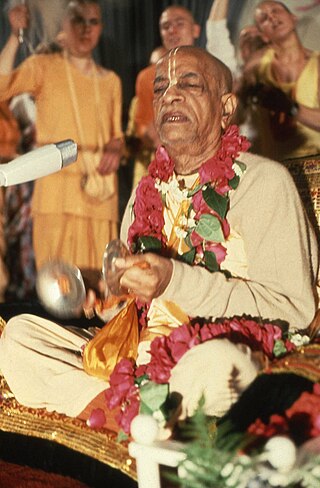
A. C. Bhaktivedanta Swami Prabhupada was a spiritual, philosophical, and religious teacher from India who spread the Hare Krishna mantra and the teachings of "Krishna consciousness" to the world. Born as Abhay Charan De and later legally named Abhay Charanaravinda Bhaktivedanta Swami, he is often referred to as "Bhaktivedanta Swami", "Srila Prabhupada", or simply "Prabhupada".

The International Society for Krishna Consciousness (ISKCON), known colloquially as the Hare Krishna movement, is a Gaudiya Vaishnava Hindu religious organization. It was founded on 13 July 1966 in New York City by A. C. Bhaktivedanta Swami Prabhupada. Its main headquarters is located in Mayapur, West Bengal, India.

The Hare Krishna mantra, also referred to reverentially as the Mahā-mantra, is a 16-word Vaishnava mantra mentioned in the Kali-Saṇṭāraṇa Upaniṣad. In the 15th century, it rose to importance in the Bhakti movement following the teachings of Chaitanya Mahaprabhu. This mantra is composed of three Sanskrit names – "Krishna", "Rama", and "Hare".

Gaudiya Vaishnavism, also known as Chaitanya Vaishnavism, is a Vaishnava Hindu religious movement inspired by Chaitanya Mahaprabhu (1486–1534) in India. "Gaudiya" refers to the Gaura or Gauḍa region of Bengal, with Vaishnavism meaning "the worship of Vishnu". Specifically, it is part of Krishnaism—Krishna-centric Vaishnavite traditions.

The Bhagavad-Gītā As It Is is a translation and commentary of the Bhagavad Gita by A. C. Bhaktivedanta Swami Prabhupada, founder of the International Society for Krishna Consciousness (ISKCON), commonly known as the Hare Krishna movement. This translation of Bhagavad Gita emphasizes a path of devotion toward the personal God, Krishna. It was first published in 1968 in English by Macmillan Publishers, and is now available in nearly sixty languages. It is primarily promoted and distributed by members of ISKCON.

Satsvarupa das Goswami is a senior disciple of Bhaktivedanta Swami Prabhupada, who founded the International Society for Krishna Consciousness (ISKCON), better known in the West as the Hare Krishna movement. Serving as a writer, poet, and artist, Satsvarupa dasa Goswami is the author of Bhaktivedanta Swami's authorized biography, Srila Prabhupada-lilamrta. After Prabhupada's death, Satsvarupa dasa Goswami was one of the eleven disciples selected to initiate future disciples. Satsvarupa dasa Goswami is one of the first few Westerners ordained by Bhaktivedanta Swami in September 1966. He is a Vaishnava writer, poet, and lecturer, who published over a hundred books including poems, memoirs, essays, novels, and studies based on the Vaishnava scriptures.

Kirtanananda Swami, also known as Bhaktipada, was a Gaudiya Vaishnava guru and the co-founder of New Vrindaban, a Hare Krishna community in Marshall County, West Virginia, where he served as spiritual leader from 1968 until 1994.

Jayadvaita Swami, a Gaudiya Vaishnava swami, is an editor, writer, publisher, and teacher and a disciple of A. C. Bhaktivedanta Swami Prabhupada, founder of the International Society for Krishna Consciousness (ISKCON). He was the seniormost editor for the Bhaktivedanta Book Trust for more than forty years. He served as a trustee for the Book Trust from 1988 through 2017. He has been described as "one of ISKCON's most independent-minded and respected thinkers." He is the author of Vanity Karma: Ecclesiastes, the Bhagavad-gita, and the meaning of life, a cross-cultural commentary on the biblical book of Ecclesiastes. The book won the 2016 Benjamin Franklin Book Award from the Independent Book Publishers Association as the best book in the "religion" category.
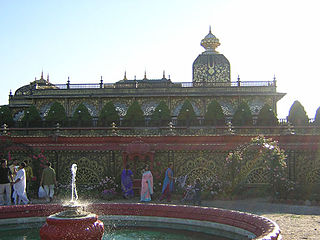
New Vrindaban is an unincorporated area and an ISKCON intentional community located in Marshall County, West Virginia, United States, near Moundsville. The town consists of 1,204 acres (4.87 km2), and several building complexes, homes, apartment buildings, and businesses including the Sri Sri Radha Vrindaban Chandra Temple and Prabhupada's Palace of Gold. New Vrindaban was founded in 1968 under the direct guidance of A.C. Bhaktivedanta Swami Prabhupada, founder of ISKCON, by his disciple Kirtanananda Swami. It is named for the Indian city of Vrindavan.

The Radha-Krishna Temple is the headquarters of the International Society for Krishna Consciousness (ISKCON) in the United Kingdom since the late 1960s. It was founded in Bury Place, Bloomsbury, by six devotees from San Francisco's Radha-Krishna Temple, who were sent by ISKCON leader A.C. Bhaktivedanta Swami Prabhupada to establish a UK branch of the movement in 1968. The Temple came to prominence through George Harrison of the Beatles publicly aligning himself with Krishna consciousness. Among the six initial representatives in London, devotees Mukunda, Shyamsundar and Malati all went on to hold senior positions in the rapidly growing ISKCON organisation.
Indradyumna Swami is an initiating guru in the International Society for Krishna Consciousness, which belongs to the Gaudiya-Vaishnava sampradaya. He is a disciple of His Divine Grace A.C. Bhaktivedanta Swami Prabhupada who introduced the Gaudiya Vaisnava, or Bhakti Yoga, tradition to the western world and formalized its spread by founding ISKCON in 1966.
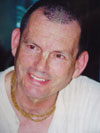
Hansadutta Das, formerly Hansadutta Swami, born 27 May 1941 in Braunschweig, Germany, died 25 April 2020 in California, was a Gaudiya Vaishnava spiritual leader. An early member of, and later guru in, the International Society for Krishna Consciousness (ISKCON), he was one of the senior disciples of ISKCON founder A. C. Bhaktivedanta Swami Prabhupada.

Jayatirtha Das, formerly Jayatirtha Goswami, was one of the leading disciples of A. C. Bhaktivedanta Swami Prabhupada and a guru within the International Society for Krishna Consciousness. Born James Edward Immel and also known as Tirthapada, Bhakti Vijaya Tirtha and Vijaya Acharya, Jayatirtha was appointed a life trustee of the Bhaktivedanta Book Trust by his guru, Prabhupada, who also placed him in the managerial post of the fledgling Spiritual Sky company. Under Jayatirtha's able management the company became a multimillion-dollar concern and the Wall Street Journal covered the company's success with a front-page article.
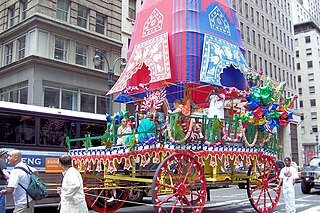
Jayananda Dasa was an influential religious figure in the International Society for Krishna Consciousness (ISKCON) in San Francisco between 1967–1977. ISKCON views Jayananda Dasa as a saint. Jayananda's guru, Srila A. C. Bhaktivedanta Swami Prabhupada, said that he was proud that he had such a good disciple as Jayananda, and when Jayananda left his body (died), Prabhupada said: "Jayananda went back home to Godhead."
Back to Godhead is the main magazine of the International Society for Krishna Consciousness (ISKCON), also known as the Hare Krishna Movement. The magazine was founded by A. C. Bhaktivedanta Swami Prabhupada in 1944, under the direction of his spiritual guru, Bhaktisiddhanta Sarasvati. It was originally published by A. C. Bhaktivedanta Swami Prabhupada and later by Satsvarupa dasa Goswami and Jayadvaita Swami.

An ISKCON guru is a person who is permitted to initiate disciples into the International Society for Krishna Consciousness system. The guru system has undergone several changes and reform since its beginnings in the 1960s. Upanayana as a traditional "sacred thread ceremony" of the Gayatri Mantra, commonly known Hindu Samskara, is complemented by Pancaratric mantras of the Gaudiya Vaishnava sampradaya and follows the principal initial nama initiation ceremony, referred to respectively as brahmana diksa and Hari nama diksa.

Sri Sri Radha Parthasarathi Mandir, generally known as the ISKCON Delhi temple, is a well known Vaishnav temple of Krishna and Radha in the form of Radha Parthasarathi. The Temple was inaugurated on 5 April, 1998 by the then Prime Minister of India, Atal Bihari Vajpayee in the presence of former Chief Minister of Delhi, Sahib Singh Verma, and Sushma Swaraj. It is located at Hare Krishna Hills, in the East of Kailash area of New Delhi, India.

The Bhagavad Gita As It Istrial in Russia was a trial that commenced in 2011 about banning the Russian edition of the book Bhagavad Gita As It Is (1968), a translation and commentary of the Hindu holy text Bhagavad Gita, on charges that the commentaries fomented religious extremism. It contains a translation and commentary by A.C. Bhaktivedanta Swami Prabhupada, founder of the International Society for Krishna Consciousness (ISKCON), commonly known as the Hare Krishna movement.
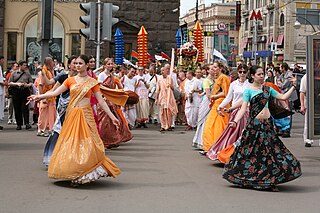
Festival of Chariots refers to the Ratha Yatra festivals run by the International Society for Krishna Consciousness (ISKCON). The main event is a chariot procession through the streets. The procession may then be followed by performing arts presentations on the stage and visiting various booths encamped at a park site. The festivals involve chants, the arts, music, and free vegetarian feasts that can be seen over the world but specifically in the United States. ISKCON, commonly referred to as Hare Krishna is a branch of Hindu religiosity. ISKCON have used the practice of Hindu festivals as an important element of Hare Krishna expression, and is a recognisable feature of their appearance in the public realm. Kirtan is an element that is common to all ISKCON festivals. Kirtan is a process of musical worship, that is accessible for group participation and as described by Edwin Bryant as “Krishna in vibratory form”. The practice of kirtan are melodies, mantras, spiritual texts that proclaim God's name in his many forms. The ‘Festival of India’ is the International society for Krishna consciousness conveying Indian expression in the global sphere.

Hridayananda das(a) Goswami is an American Vaishnava leader and preacher, one of the leading spiritual leaders of the International Society for Krishna Consciousness (ISKCON) and one of the most distinguished disciples and close friend of ISKCON founder Bhaktivedanta Swami Prabhupada, who appointed him as preacher. H.D. Goswami is a guru and member of the ISKCON Governing Body Commission since 1974.




















